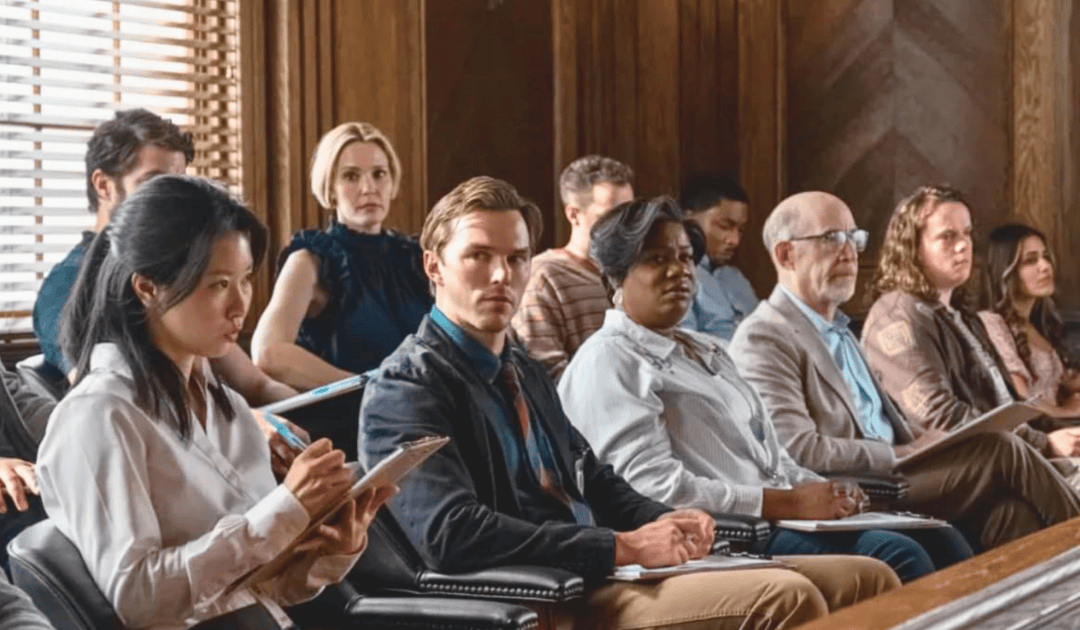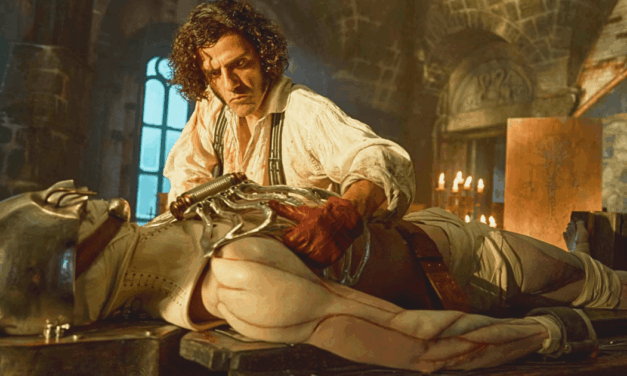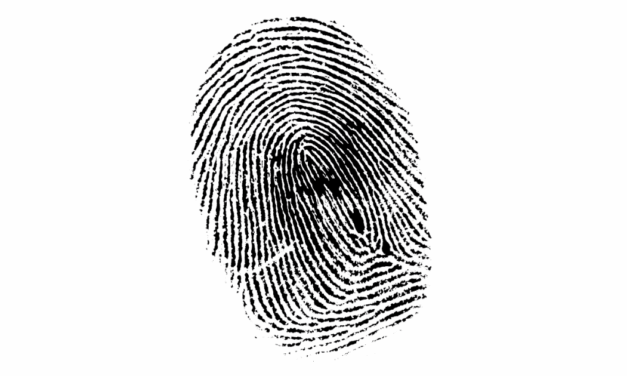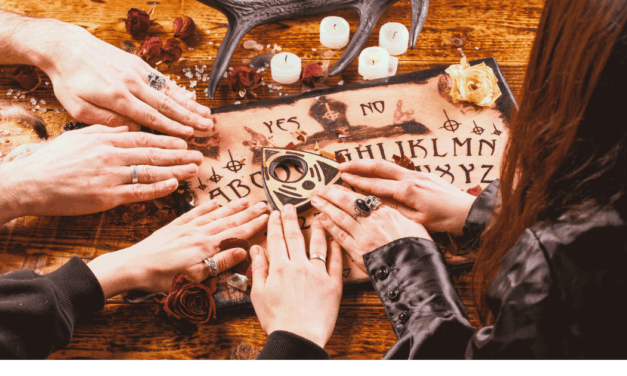Listen to this article (17:31 min)
This article was published exclusively online for the Christian Research Journal, volume 48, number 02 (2025).
When you support the Journal, you join the team and help provide the resources at equip.org that minister to people worldwide. These resources include our ever-growing database of more than 2,500 articles and Bible Answers, as well as our free Postmodern Realities podcast.
Another way you can support our online articles is by leaving us a tip. A tip is just a small amount, like $3, $5, or $10, which is the cost of a latte, lunch out, or coffee drink. To leave a tip, click here
[Editor’s Note: WARNING — This article contains significant spoilers for Juror #2, including key plot twists.]
Juror #2
Directed by Clint Eastwood
Written by Jonathan Abrams
Produced by Clint Eastwood, Tim Moore, Jessica Meier, Adam Goodman, Matt Skiena
Starring Nicholas Hoult, Toni Collette, J. K. Simmons, Kiefer Sutherland
(Warner Bros. Pictures, 2014)
Feature Film (PG–13)
Juror #2 is a legal thriller co-produced and directed by Clint Eastwood and written by Jonathan Abrams. It’s set in Savannah, Georgia, and revolves around Justin Kemp (Nicholas Hoult), a journalist who, as he serves on a murder trial jury, comes to realize that he’s responsible for the victim’s death.
The Story. The victim is Kendall Carter (Francesca Eastwood). The accused is her boyfriend James Michael Sythe (Gabriel Basso), who’s bearded, rough-around-the-edges, and impulsive and has a questionable past — not the kind of guy you want your daughter bringing home for the holidays.
As the trial gets underway, we learn that Sythe got drunk at a local bar, became unruly, and had a loud argument with Carter. She walked away in the pouring rain. Sythe appears to pursue her, and she turns up dead under a bridge.
Meanwhile, Kemp initially presents as highly polished — clean-shaven, smooth, and contemplative, as well as a loving husband and expectant father. We later learn that there’s more than meets the eye. Kemp is a recovering alcoholic who was at the local bar the night Carter and Sythe argued.
Sythe becomes a victim of circumstantial evidence — his prior life, the coroner’s testimony (battery with a blunt object), and an over-eager eyewitness placing him at the scene. We later learn that Sythe’s vehicle made a U-turn away from Carter’s walking path, while Kemp continued down her path in the rain, hit something, saw a deer crossing sign, but after looking around briefly, drove home.
Kemp realizes that Sythe is innocent and thinks that his legal predicament will go away with a not-guilty verdict. Kemp consults with lawyer and AA sponsor, Larry Lasker (Kiefer Sutherland), who says that if Sythe goes free, Kemp will get convicted since Prosecutor Faith Killebrew (Toni Collette) hinged her DA election bid on a conviction, Kemp was at the bar that fateful night, and he also had prior DUIs. Nevertheless, Kemp pushes for Sythe’s innocence but faces an uphill battle with the other jurors.
Juror Harold Chicowski (J. K. Simmons), a retired detective, suggests that Sythe may be on trial due to confirmation bias. Another juror questions the eyewitness account due to poor visibility, and yet another (a medical student) says Carter’s injuries are consistent with a hit and run. Chicowski gathers a list of vehicles brought to local body shops around the time Carter died. This investigation defies the judge’s jury pre-instruction forbidding such investigations. Feeling the heat, Kemp acts like he wants to work with Chicowski on the list but drops the papers “accidentally” outside court in front of the bailiff, who promptly takes Chicowski and Kemp inside to face Judge Thelma Hollub1 (Amy Aquino), where counsel and the accused also are present. Chicowski’s excused.
Killebrew begins visiting the listed, registered vehicle owners, including Kemp’s wife, Allison Crewson (Zoey Deutch), who innocently repeats the false story Kemp fed her about taking another path home. When Kemp comes home, Crewson tells him about Killebrew’s visit and presses him on the path he took home. He finally comes clean about his bar visit (without sipping), as well as his real path home, and they decide to protect themselves at all costs. When the jury returns, Kemp isn’t there but is at the hospital with his wife and newborn daughter. The jury foreperson delivers a guilty verdict on the murder count. The judge thanks and excuses the jury.
Kemp strangely shows up for sentencing. Killebrew looks back to see him and has a lightbulb moment. Sythe gets sentenced to life without parole. After sentencing, Killebrew and Kemp speak outside. She knows what happened but doesn’t directly say it. She says whoever is responsible for Carter’s death deserves to face justice. In response, he suggests that she not rock the boat given her election (especially since Sythe is bad news anyway), and he also says that if she pursues things, a good family will suffer.
One night, Kemp hears police sirens but is relieved when they drive on. On another day, as he and his wife play with their baby, someone knocks. Kemp opens the door to Killebrew who just stares him down. The screen fades to black.
Legal Lessons. Juror #2 is well-written and acted and is a good watch, scoring 93 percent on the Rotten Tomatoes Tomatometer (All Critics) and 91 percent on its Popcornmeter (Verified Audience).2 More importantly, however, the film teaches us several important lessons about our legal system and, ultimately, about ourselves.
Importance of Jury Service. Some trials are “bench trials” presided over by judges who also serve as factfinders. But some trials require or allow juries. Notwithstanding the system’s ongoing need for jurors, it’s a running joke for some to evade serving. Is this right? First, we’re called to obey lawful mandates (Romans 13:1–3), and the call to serve starts with a jury summons, a legal mandate. Second, if everyone evaded service, our system would grind to a halt, and that system exists to protect us all. Surprisingly, even some lawyers who know better try evading. I once reported, and three other lawyers in the jury pool whined in open court about how busy (read: important) they were so that they could get excused. When it came to my turn, the judge asked, “Aren’t you going to try to get off too?” I said, “No, Your Honor, I depend on our community to serve when cases go to trial, and I would be honored to serve.” Everyone was shocked. Certainly, some people cannot serve when called (e.g., service members on active duty, primary caretakers, those who would suffer financial hardship, etc.). In some circumstances, those called can postpone until convenient. As believers, we should be willing to embrace our civic duty to serve to obey God and for the greater good of our legal system. Our knee-jerk reaction shouldn’t be how to get out, but rather, how to serve, if possible.
No Independent Investigations. Chicowski’s body shop investigation raises all kinds of issues. To a layperson, his investigation might initially appear to be morally justified — who, after all, wouldn’t want to ascertain the truth? But what he did threatens the entire system. Trials, by legal design, are closed-universe systems. No juror is allowed to conduct extra-judicial investigations. Jurors are not investigators. They are factfinders based solely on the evidence the judge admits.
The rules of evidence that, in part, forbid independent investigations are designed to ensure that only trustworthy evidence reaches the jury. The goal is to prevent judicial taint. Laypeople might struggle at first with this kind of rigor because it’s so different from everyday life (e.g., Child: “Mommy, Sally told me…” Mom: “Objection, calls for hearsay!”).
Perhaps it helps to think of the rules of evidence simply as a higher standard designed to try to protect trial outcomes as much as is humanly possible. By analogy, home kitchens don’t require exacting cleanroom standards requiring a sterile environment to protect against possible contamination (e.g., air filters, controlled temperatures and humidity levels, proper airflow, special attire, and personal protective equipment, etc.). Cleanroom standards, though different from everyday life, certainly have their appropriate time and place. The same is true for the rules of evidence — a higher standard to prevent judicial contamination. Among other things, the rules of evidence preclude evidence that is or could be unfounded, irrelevant, prejudicial, redundant, speculative, inferior, and unreliable. The judge exists as the gatekeeper to decide what evidence gets admitted solely upon which the jury is to base its findings.
The upshot is that the rules of evidence may preclude the jury from learning about or relying on some true facts, but given our finitude and propensity to err, no better way currently exists to prevent miscarriages of justice.3
One Bad Decision After Another. The story in Juror #2 really is like the Dr. Seuss children’s classic Because a Little Bug Went Ka-Choo! in which a bug sneezes leading to one consequence after another until total chaos reigns. While the bug innocently sneezed, Kemp culpably made one bad (unethical) decision after another, each with serious consequences.
His first bad decision on the night in question was not calling the police right away. Had he done that, the rest of the story never would have unfolded — it was only an unfortunate accident in bad weather conditions. That single decision set everything else in motion.
His second bad decision was lying to his wife about his path home to hide the truth that he had relapsed, of sorts, by going to the bar that night and ordering a drink, even if he never took a sip.
His third bad decision was not coming forward as soon as he remembered overhearing the bar argument. True, he was just starting to recall facts when this scene unfolds, but had he come forward then, he would have been excused from further service.
His fourth bad decision was calling attention to Chicowski’s body shop list. That decision led Killebrew to start investigating the list (something she’s allowed to do).
His fifth bad decision was covering up the truth after he realized he was responsible for what happened. This decision went from bad to worse by holding Sythe guilty.
In the end, Kemp made a series of unethical decisions, each leading to additional dire consequences, culminating in pinning his guilt on Sythe, something the end of the film reveals will result in harsh legal consequences for him and his family. He selfishly covered up the truth using an ends-justifies-the-means ethic, but by doing so, he made things far worse for them all.
Presumed Innocent. One major theme that jumps out of the film is that the seemingly guilty are innocent (Sythe), while the seemingly innocent are guilty (Kemp).
Notwithstanding the rigors of our system, miscarriages of justice happen (e.g., O. J. Simpson). Human justice, by definition, is imperfect because all who participate in it — the accused, witnesses, counsel, judge, and jurors — are imperfect. As so poignantly portrayed in the film, what a jury concludes happened might not be what happened. Sometimes the system gets it right, but sometimes, as in Sythe’s case, the system tragically gets it very wrong (though in his case, it appears to be short-lived).
Whenever a film like Juror #2 comes along, believers ask why we presume innocence until guilt is proven. From a public policy standpoint, the answer seems straightforward: presuming innocence puts the proof burden on the state as a check against overreach and tyranny, ultimately protecting us all.
What some believers might not realize, however, is that the principle of presumed innocence is deeply rooted in the Bible itself. Two Old Testament (OT) passages speak directly to it. Deuteronomy 17:6 says that “on the evidence of two witnesses or of three witnesses the one who is to die shall be put to death; a person shall not be put to death on the evidence of one witness.”4 Deuteronomy 19:15 adds that “a single witness shall not suffice against a person for any crime or for any wrong in connection with any offense that he has committed. Only on the evidence of two witnesses or of three witnesses shall a charge be established.” These two OT passages yield at least three principles of biblical justice: (1) Due process (fairness) must govern all legal proceedings (“for any crime or for any wrong”); (2) The burden of proving legal guilt must be satisfied (in this instance, “two or three witnesses”); and (3) If this proof burden is not satisfied, the accused should not be convicted or punished (“a person shall not be put to death on the evidence of one witness” and “[o]nly on the evidence of two witnesses or of three witnesses shall a charge be established”). Particularly noteworthy is the divine proclamation that apart from such corroborating evidence, the accused walks even if he committed the offense (“any offense that he has committed”). God does not say “any offense that he allegedly has committed.” God assumes both the offense and an inability to prove it.
God’s Law is “holy and just and good” and “spiritual” (Romans 7:12, 14 NKJV); and Christ came not “to abolish” but “to fulfill” it (Matthew 5:17). The New Testament (NT) assumes, applies, and expands the OT justice principles beyond the legal context. The author of Hebrews says that some who violated the Law “die[d] without mercy on the evidence of two or three witnesses” (Hebrews 10:28). Paul forbids uncorroborated accusations against elders: “Do not admit a charge against an elder except on the evidence of two or three witnesses” (1 Timothy 5:19). Christ taught us how to handle disputes between church members by proclaiming that “if [the offending brother] does not listen, take one or two others along with you [the offended brother], that every charge may be established by the evidence of two or three witnesses” (Matthew 18:16). Paul did so as well by writing, “[t]his is the third time I am coming to you. Every charge must be established by the evidence of two or three witnesses” (2 Corinthians 13:1). The NT repeatedly affirms, applies, and expands the OT justice principles.
Seeing Kemp in Ourselves. One of the most sobering truths in Juror #2 is one we miss when we — ironically — act just like Kemp. We pretend otherwise, but deep down, we’re all far more like Kemp (guilty perpetrator) than Sythe (innocent victim).
The sad truth is that we all have sinned by failing to abide by God’s Word (Romans 3:23), and the “wages of sin is death” (6:23). We all are capital offenders before God. By violating one part of His Law, we have violated it all (James 2:10). We may never have hit someone with our car and pinned it on an innocent person, but we all are spiritual manslayers since we all have had unrighteous anger (Matthew 5:21–22). We suppress this biblical truth in unrighteousness too (reminiscent of the line in the film from the AA meeting that “we’re only as sick as our secrets”). We’re so good at showing up at church in our “Sunday best,” totally polished on the outside, while simultaneously denying the inner reality of who we really are in secret in our thoughts, words, and deeds before an all-seeing God.
We all, like Kemp, are guilty before God. We also are responsible for what we’ve done, such that we, like Kemp, need to face and satisfy the demands of justice. But what we cannot do ourselves already has been done for us. Christ, though perfectly innocent, fully faced and satisfied the demands of justice for us — He who knew no sin became the punishment of sin for us that we might become the righteousness of God in Him (2 Corinthians 5:21). He died for us, the just for the unjust (1 Peter 3:18). And He gloriously rose for us, forever conquering sin and death. He also ascended to the right hand of the Father where He is our eternal Advocate (1 John 2:1). He pleads His life, death, resurrection, and ascension for us. He defends us. He intercedes for us. He comforts us.
He also calls us, once saved, to imitate Him by serving those in need since He came not to be served but rather to serve and to give His life as a ransom for many (Matthew 20:28). Our service will vary depending on our gifts and callings. Some will serve primarily in their homes or within church walls, while others, far beyond them. Some, on skid row, while others, on death row. Some, before a crime is committed, while others, afterward. May we, by God’s grace, continually shed the Kemp hidden within us and serve the Sythes in plain view all around us. —David Hagopian
David Hagopian is Partner and General Counsel at CDF Labor Law, in Irvine, California, where he is an employment defense and business trial attorney.
NOTES
- The judge’s name plate in her courtroom uses the last name of Stewart.
- “Juror #2,” Rotten Tomatoes, accessed April 2, 2025, https://www.rottentomatoes.com/m/juror_2.
- Viewers are left to wonder why public defender Eric Resnick (Chris Messina) didn’t himself present the possibility of a hit-and-run theory to exonerate Sythe. He might even have been able to present the body shop list himself and point out that Sythe’s vehicle showed no visible signs of damage (even the jury, during deliberations, wondered whether his car sustained any damage).
- Bible quotations taken from the ESV, unless noted otherwise.









